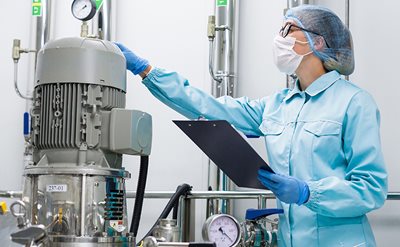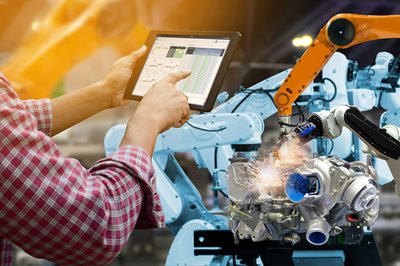During the best of times, uncertainty, risk, and volatility were simply the cost of doing business for manufacturers. However, the sudden and unanticipated arrival of COVID-19 has brought unseen levels of disruption to not only manufacturing operations, but also all aspects of life as we know it.
Personal disruptions have come in the form of social distancing and stay-at-home mandates. Meanwhile, businesses have been forced to switch to remote work, improvise methods for meeting health and safety guidelines, or—in some cases—close up shop temporarily.
For manufacturers, the operational challenges—including supply chain interruptions—due to COVID-19 have only shined a brighter light on the process weaknesses and technology limitations that have unfortunately plagued the industry for too long.

As the world looks at a return to normalcy, manufacturers shouldn’t expect to return to business as usual—not if they want to succeed in the brave new world taking shape before our eyes. Instead, proactive changes made now will pave the way for manufacturing in a post-COVID-19 world. It’s a transformational journey that we can split into three phases: survive, recover, and thrive.
- To survive, flexibility is paramount
Manufacturing during a pandemic puts organizations under immense pressure to maintain operational efficiency and uphold product quality and safety—during less than optimal conditions. For example, many have had to reduce the number of employees working per shift, making social distancing easier but reducing production capacity.
Others have allocated staff deemed “non-essential” to plant-floor operations—such as quality professionals and plant managers—to work from home, including some for the very first time. Among the manufacturers that have relied largely on paper-based processes or on-premises software for quality management, this has presented a challenge in providing remote employees access to critical quality and process data.
On a brighter note, there have also been notable examples of companies pivoting to completely new product categories to do their part in the fight against COVID-19, such as breweries and distilleries switching to producing hand-sanitizer or other manufacturers pledging their factories to produce personal protective equipment (PPE) for healthcare workers. These are certainly commendable efforts but also require manufacturing environments and quality procedures that can quickly adapt as necessary.

All of these cases reveal the need for flexibility to survive in the current COVID-19 reality. Now more than ever, manufacturers should consider the role that technology can play in enabling this flexibility—to support production processes, quality control, and employees. For instance, those struggling with reduced plant-floor staff and remote teams can look to cloud-based quality management solutions.
- For plant-floor operators who may be stretched thin at the moment, such solutions can automate routine activities such as data collection, process monitoring, and reporting to help keep up with critical quality and safety checks.
- Remote quality teams can receive automated alerts to plant-floor problems and even observe performance trends to ensure corrective actions are taken to prevent larger issues.
- When standardized across multiple lines and sites, these solutions can also help company leaders run cross-plant analyses to identify opportunities for improvement and ways to align best practices across the entire enterprise, all safely from home.
Real-time access to quality data and the ability to analyze and respond to those data are all worthwhile investments that can help organizations get through the current situation and optimize operations as part of broader digital transformations for the future.
- Recover by thinking beyond firefighting
The following phase—recovery—doesn’t mean a return to the way things were before, as I mentioned above. The truth is the impact of COVID-19 will be felt long after the dust settles. This may mean some employees working from home indefinitely or sites continuing to run with reduced staff numbers per shift. Manufacturers need to start planning ahead for the long-term transformation of their operations and adapt to the “new normal” emerging out of the pandemic, rather than just deploying temporary solutions.

One of the first initiatives to consider is moving beyond “firefighting” to more tactical responses. Many have historically taken this reactive approach to quality control and manufacturing overall, where issues arise and teams scramble to respond, only to have the same problems flare-up time and time again. But, in addition to being time-consuming and tiresome, firefighting for long periods of time is neither strategic nor sustainable.
Instead, the way forward is for manufacturers to learn from the crisis and proactively identify pain points across their operations. These may include challenges in access to data, decision making, or simply initial response to COVID-19. From this understanding, it’s possible to work through sustainable, tactical improvements to eliminate these pain points, including through the effective use of technologies.
Some questions to consider include but are not limited to:
- Do we have the tools necessary for employees to work remotely?
- How are our technology limitations impacting productivity?
- Where are there gaps in our data and understanding of process performance?
- Where do we have operational blind spots within individual plants? Across the enterprise?
Organizations can then build a vision for the future with a pipeline of short-term and long-term transformation opportunities that outline a path, from recovery to thriving in the post-pandemic world.
- Thrive through digital transformation
Perhaps the biggest lesson to take away from COVID-19 is the imperative around digital transformation. Once a lower priority on company budgets and agendas, it has suddenly been pushed to the forefront of investment, especially among manufacturers who found deficiencies in their technology and infrastructure impaired their ability to respond and pivot operations when the outbreak began.

Now, more manufacturers want to create nimble, flexible, and proactive manufacturing environments—driven by data. It indicates a remarkable shift from the investments in electro-mechanical automation seen over recent decades, which primarily focused on improving efficiency and productivity.
We now can do more than automate manufacturing. We can optimize processes, giving manufacturers intelligent means of understanding what’s happening on the plant floor so they can make informed decisions to drive enhancements and adjust operations accordingly. The results are agility and resilience, which are exactly what we need to thrive now and long into the future.
To support manufacturers during the COVID-19 crisis, we at InfinityQS are offering free use of our Enact® Quality Intelligence platform—which includes tools to support remote workers, empower onsite staff, and optimize operations—for three months. To learn more or sign up to begin, please visit:
https://www.infinityqs.com/connect/giving-back-with-enact.